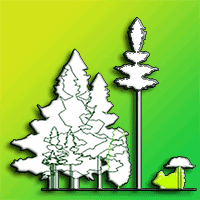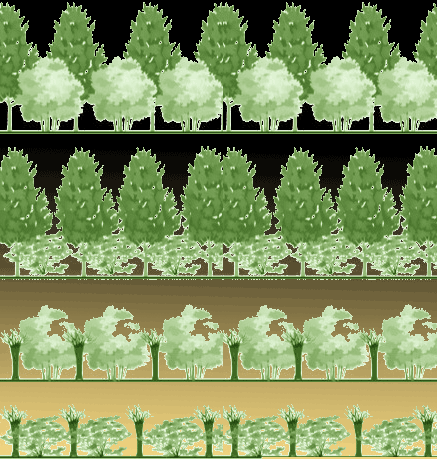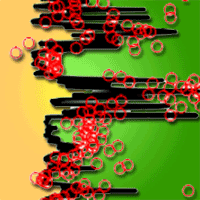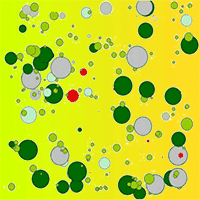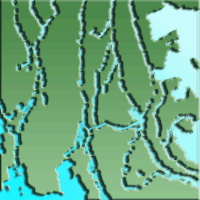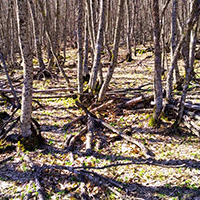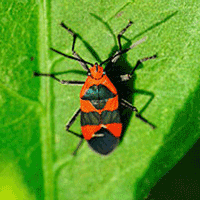
Arthropod diversity in pure oak forests of coppice origin in northern Thrace (Turkey)
Akif Keten (1) , Vedat Beskardes (2), Meric Kumbasli (1), Ender Makineci (3), Hayati Zengin (4), Emrah Özdemir (5), Ersel Yilmaz (5), Hatice Cinar Yilmaz (6), Servet Caliskan (7), James T Anderson (8)
iForest - Biogeosciences and Forestry, Volume 8, Issue 5, Pages 615-623 (2014)
doi: https://doi.org/10.3832/ifor1318-007
Published: Dec 17, 2014 - Copyright © 2014 SISEF
Research Articles
Abstract
Oak (Quercus spp.) forests are among the most important forest types in Turkey. In the past, oak forests were managed through coppice clear-cutting, but in recent decades they have mostly been converted to high forest. This study was aimed at explaining how arthropod diversity is affected during conversion from coppice to high oak forest and during the early stages of coppice succession. We tested the hypothesis that arthropod richness, abundance and diversity in coppice oak sites varied according to stand age and a number of other forest characteristics. Arthropod communities were sampled in 50 plots using four different methods: pitfall traps, sweep nets, sticky cards and cloth shaking. A total of 13 084 individuals were collected and classified into 193 Recognizable Taxonomic Units (RTUs), with the most RTUs and the greatest number of specimens captured by sweep netting. We identified 17 taxa within RTU’s with more than 1% of the captured arthropods, which constituted 75% of the total specimens. The number of RTUs varied significantly according to trap type. Arthropod richness and Shannon-Wiener biodiversity index (H′) increased with elevation and precipitation. In young (1-40 yrs-old) and middle-aged (41-80 yrs) stands, arthropod biodiversity was not significantly affected by stand type, but slightly increased with diameter at breast height and tree height. Forest characteristics, such as the litter layer, understory and crown diameter, weakly influenced arthropod richness and abundance. Cluster analysis revealed that stand types and trap types differed taxonomically. Principal component analysis showed that stand types were clearly separated by the stand parameters measured. Insect families (Formicidae, Thripidae, Lygaeidae, Dolichopodidae, Luaxanidae, Cicadellidae and Ichneumonidae) could potentially be used as indicators of coppice oak conditions. As the coppice oak changes to mature forest, further studies are needed to better assess the relation between arthropods, forest types and structural characteristics of stands.
Keywords
Elevation, Quercus, Recognizable Taxonomic Units, Trap Types, Stand Types, Stand Characteristics
Authors’ Info
Authors’ address
Meric Kumbasli
Duzce University, Faculty of Forestry, Wildlife Ecology and Management, Duzce (Turkey)
Istanbul University, Faculty of Forestry, Forest Entomology and Protection Department, Istanbul (Turkey)
Istanbul University, Faculty of Forestry, Soil Science and Ecology Department, Istanbul (Turkey)
Duzce University, Faculty of Forestry, Department of Forest Management, Duzce (Turkey)
Ersel Yilmaz
Istanbul University, Faculty of Forestry, Forest Yield and Biometry Department, Istanbul (Turkey)
Istanbul University, Forestry Vocational High School, Ornamental Plants Growing Program, Istanbul (Turkey)
Istanbul University, Faculty of Forestry, Silviculture Department, Istanbul (Turkey)
West Virginia University, Division of Forestry and Natural Resources, Morgantown, West Virginia (USA)
Corresponding author
Paper Info
Citation
Keten A, Beskardes V, Kumbasli M, Makineci E, Zengin H, Özdemir E, Yilmaz E, Yilmaz HC, Caliskan S, Anderson JT (2014). Arthropod diversity in pure oak forests of coppice origin in northern Thrace (Turkey). iForest 8: 615-623. - doi: 10.3832/ifor1318-007
Academic Editor
Massimo Faccoli
Paper history
Received: Apr 20, 2014
Accepted: Aug 19, 2014
First online: Dec 17, 2014
Publication Date: Oct 01, 2015
Publication Time: 4.00 months
Copyright Information
© SISEF - The Italian Society of Silviculture and Forest Ecology 2014
Open Access
This article is distributed under the terms of the Creative Commons Attribution-Non Commercial 4.0 International (https://creativecommons.org/licenses/by-nc/4.0/), which permits unrestricted use, distribution, and reproduction in any medium, provided you give appropriate credit to the original author(s) and the source, provide a link to the Creative Commons license, and indicate if changes were made.
Web Metrics
Breakdown by View Type
Article Usage
Total Article Views: 52882
(from publication date up to now)
Breakdown by View Type
HTML Page Views: 44348
Abstract Page Views: 2552
PDF Downloads: 4356
Citation/Reference Downloads: 23
XML Downloads: 1603
Web Metrics
Days since publication: 4023
Overall contacts: 52882
Avg. contacts per week: 92.01
Citation Metrics
Article Citations
Article citations are based on data periodically collected from the Clarivate Web of Science web site
(last update: Mar 2025)
Total number of cites (since 2015): 8
Average cites per year: 0.73
Publication Metrics
by Dimensions ©
Articles citing this article
List of the papers citing this article based on CrossRef Cited-by.
References
Ground-dwelling spider (Araneae) and carabid beetle (Coleoptera: Carabidae) community assemblages in mixed and monoculture stands of oak (Quercus robur L./Quercus petraea (Matt.) Liebl.) and Scots pine (Pinus sylvestris L.). Forest Ecology and Management 321: 29-41.
CrossRef | Gscholar
Trakya’da mese ormanlarinin tür zenginligi, koruya dönüstürülmesi ve önemi.[Species richness, converted to high forest, and importance of oak forests in Thrace]. In: Proceedings of the “IV Industrialization and Enviromental Symposium in Thrace”. Edirne (Turkey) 14-15 Oct 2005. Bildiriler Kitabi, Edirne, Turkey, pp. 381-389. [in Turkish]
Gscholar
Kuzey Trakya koruya tahvil mese ekosistemlerinde saglik durumu, biyokütle, karbon depolama ve faunistik özelliklerin belirlenmesi [Determination of health condition, biomass, carbon sequestration and faunistic characteristics on conversion of coppice oak ecosystems in Northern Thrace]. TÜBITAK Project, TUBITAK-TOVAG 107O750, Turkey. [in Turkish]
Gscholar
Spider assemblages (Arachnida: Araneae) as indicators for degraded oligotrophic moors in north-east Germany. In: Proceedings of the “21st European Colloquium of Arachnology. European Arachnology 2003” (Logunov DV, Penny D eds). St. Petersburg (Russia) 4-9 August 2003. Arthropoda Selecta Special Issue 1: 249-260.
Gscholar
Trakya vejetasyonuna genel bakis ve Igneada Subasar (Longos) Ormanlari [Thrace vegetation overview and Igneada Longos Forests]. Journal of the Faculty of Forestry of the Istanbul University / I.U. Orman Fakültesi Dergisi Seri B 38 (1): 69-75. [in Turkish]
Gscholar
Demirköy (Istranca Daglari/ Trakya Bölgesi) ve civarinin orman vejetasyonu [Forest vegetation of Demirköy (Strandja Mountain / Thrace Region) and environs]. Ekoloji ve Çevre Dergisi 35: 13-18. [in Turkish]
Gscholar

